Ken and Yetta Goodman
Brief report of our visit to Israel
December 19, 1999- January 13, 2000
History
of this trip:
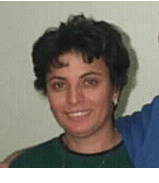 For
about two years we have had interest in our making a professional visit
to Israel. We had invitations from Elana Zeiler, Director of Elementary
Eduation and Bilha Artzi of the Israel Ministry of Education, and from
Dr. Ruwaida Abu-Rass faculty member of Beit Berl college in Kfar Saba.
Dr. Abu Rass did her doctorate at the University of Arizona. She proposed
to the United States Information Service and the Cultural Attache that
they fund our trip. They agreed and we were funded under a section of the
Fulbright Program that provides support for English Teaching. Their policy
is to support scholars for a minimum of two weeks, They made known to other
educational groups and colleges that we would be available and put together
our program from December 19 to January 5. Our work for the Ministry was
from January 6 to January 13. We made about 27 presentations over the full
period of our visit, individually or together.
For
about two years we have had interest in our making a professional visit
to Israel. We had invitations from Elana Zeiler, Director of Elementary
Eduation and Bilha Artzi of the Israel Ministry of Education, and from
Dr. Ruwaida Abu-Rass faculty member of Beit Berl college in Kfar Saba.
Dr. Abu Rass did her doctorate at the University of Arizona. She proposed
to the United States Information Service and the Cultural Attache that
they fund our trip. They agreed and we were funded under a section of the
Fulbright Program that provides support for English Teaching. Their policy
is to support scholars for a minimum of two weeks, They made known to other
educational groups and colleges that we would be available and put together
our program from December 19 to January 5. Our work for the Ministry was
from January 6 to January 13. We made about 27 presentations over the full
period of our visit, individually or together.
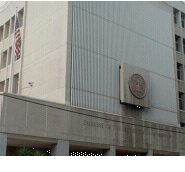 Our
schedule was arranged by Ms.
Desiree Grevler at the Cultural Attache's office in Tel Aviv and Ms.
Fay Lipshitz at the American Cultural Center in Jerusalem. We lectured
at the following teacher colleges: Beit Berl (Kfar Sava). Kaye College
(Beersheba), Levinsky College (Tel Aviv) David Yellen College (Jerusalem),
Haifa Arab Teachers College (Haifa), and the Bakaa
Teachers College in the north, which is the only Islamic Institute in Israel.
(Bakaa) . We also lectured at Bar Ilan University (Ramat Gan). Two lectures
(in Telaviv and Jerusalem) were co-sponsored by the Israeli English Teachers
Association. For the ministry we spoke at conferences at Kibbutz Kfar Giliudi
near Kiryat Shimona in the Galillee and at Kibbutz Ramat-Rachel in Jerusalem.
We consulted with educational leaders and ministry staff and visited 6
elementary and secondary schools.
Our
schedule was arranged by Ms.
Desiree Grevler at the Cultural Attache's office in Tel Aviv and Ms.
Fay Lipshitz at the American Cultural Center in Jerusalem. We lectured
at the following teacher colleges: Beit Berl (Kfar Sava). Kaye College
(Beersheba), Levinsky College (Tel Aviv) David Yellen College (Jerusalem),
Haifa Arab Teachers College (Haifa), and the Bakaa
Teachers College in the north, which is the only Islamic Institute in Israel.
(Bakaa) . We also lectured at Bar Ilan University (Ramat Gan). Two lectures
(in Telaviv and Jerusalem) were co-sponsored by the Israeli English Teachers
Association. For the ministry we spoke at conferences at Kibbutz Kfar Giliudi
near Kiryat Shimona in the Galillee and at Kibbutz Ramat-Rachel in Jerusalem.
We consulted with educational leaders and ministry staff and visited 6
elementary and secondary schools.
Some
impressions of Israel
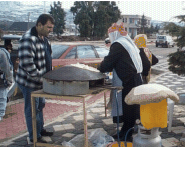 Our
only other trip to Israel was a three month visit in 1973. Change of all
kinds was obvious to us. The population has almost doubled to 6 million
including a million relatively recent arrivals from Russia and the other
former Soviet Republics. A million Arabs are citizens of Israel. And the
Jews of Israel are incredibly diverse including Falashas from Ethiopia,
North Africans, and Middle Easterners, and the Europeans including those
who came from North and South America, South Africa and Australia. Roads
are better, buildings higher, housing developments everywhere.
Our
only other trip to Israel was a three month visit in 1973. Change of all
kinds was obvious to us. The population has almost doubled to 6 million
including a million relatively recent arrivals from Russia and the other
former Soviet Republics. A million Arabs are citizens of Israel. And the
Jews of Israel are incredibly diverse including Falashas from Ethiopia,
North Africans, and Middle Easterners, and the Europeans including those
who came from North and South America, South Africa and Australia. Roads
are better, buildings higher, housing developments everywhere.
Israel
is the most connected society we've seen. Cell phones are everywhere, seemingly
in all elements of the population (though we didn't see a Bedouin on a
camel with one). Our itinerary, planned for us not by us, took us to many
parts of this tiny country. At Kfar Saba we were at Israel's narrowest
point. In Kiryat Shimona we were at the Syrian and Lebanese borders in
the North. In Beer Sheva we were in the Negev desert in the South. We toured
the Golan Heights after a rare snowfall, Nazareth, Haifa, Herzelia.We took
a walk along the Jordan river with quotations from bilbical references
to the Jordan etched in concrete
along the way. And we drove along the Jordan river on a joint use highway.
We
divided the bulk of our time between Tel Aviv and Jerusalem. In Telaviv
we stayed at a hotel near the US embassy and the Mediterranean, an area
of hotels, embassies, restaurants and hundreds of teenagers doing what
kids everywhere do on Friday night (Sabbath or no Sabbath.) Jerusalem has
a unifying characteristic Tel Aviv lacks. All buildings must be built with
the native Jerusalem stone, which is various shades of beige to yellow.
It's a city built on hills- our 17 story Sheraton Hotel there overlooked
the old city. We could clearly see the Dome of the Rock and the walls of
the old city. Many of the guests at the hotel were Chassidic families with
the men in black coats and fur hats and women in dresses and hats. The
ministry put us at a kibbutz built as a hill top fortification when Jerusalem
was still a divided city.
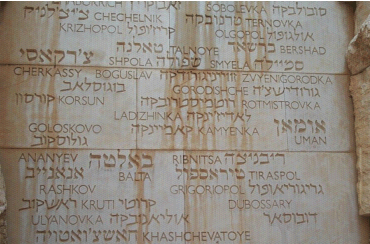
Of
all the places we visited, the Holocaust museum was still the most moving.
They now have an area called the Valley of the Communitites, where the
names of the Jewish communities wiped out in the holocaust are inscribed
on huge pillars of Jerusalem stone. We found the places Yetta's family
came from: Sokolevka, Ladizhinka, Uman, Knaze. We spent New Year's eve
visiting Prof. Bernard Spolsky at his home in the Old City. We joined him
and his wife Ellen at the wall that Sabbath evening before dinner. All
was calm and quiet.
Israel
has many political parties and many opinions on everything. There is a
wide spread longing for peace but much division over the price to pay for
it. We saw demonstrations against giving the Golan Heights back to Syria.
And we were given peace dove pins by those who believe peace must be the
highest priority. The alternatives to peace are too terrible to imagine.
Our
Work
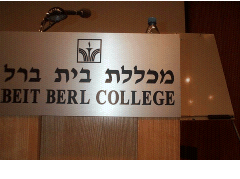 Like
many Israeli institutions, Beit
Berl College, had its roots in the Histadrrut labor movement as a school
for the children of workers to learn to be teachers. The German-Israeli
institute where we stayed was donated by the German union movement. It's
the largest college in Israel with 6000-7000 students
.Within it, there is an Arab program,
the Arabic Teacher Training Institute,
which was absorbed under a government program of merging smaller colleges.
We were sponsored by the English department, the Arab Institute, and a
child development center (Millel) housed at the college. There is a new
national English syllabus which is widely regarded as encorporating principles
of whole language and there was much interest in helping teachers to understand
the new syllabus which replaces a very traditional program of EFL education.
There is a similar shift going on in the general elementary curriculum
in Israel. Though there are Jewish and Arab students at the college, they
are usually in separate programs. We did however speak to some mixed audiences.
Because most Jewish students spend two-three years in the army after high
school and most Arab students do not, there is an age difference among
the students
Like
many Israeli institutions, Beit
Berl College, had its roots in the Histadrrut labor movement as a school
for the children of workers to learn to be teachers. The German-Israeli
institute where we stayed was donated by the German union movement. It's
the largest college in Israel with 6000-7000 students
.Within it, there is an Arab program,
the Arabic Teacher Training Institute,
which was absorbed under a government program of merging smaller colleges.
We were sponsored by the English department, the Arab Institute, and a
child development center (Millel) housed at the college. There is a new
national English syllabus which is widely regarded as encorporating principles
of whole language and there was much interest in helping teachers to understand
the new syllabus which replaces a very traditional program of EFL education.
There is a similar shift going on in the general elementary curriculum
in Israel. Though there are Jewish and Arab students at the college, they
are usually in separate programs. We did however speak to some mixed audiences.
Because most Jewish students spend two-three years in the army after high
school and most Arab students do not, there is an age difference among
the students
The
halls were full of a diverse range of students at
Kay College. in Beersheva. Beersheva
is in the Negev Desert in the South. Some of the students are Bedouins,
former nomads of the desert. The college has about 6000 students in teacher
education. There is a program for retraining Russian English teachers who
must do a year's study to be certified in Israel.
One of our audiences included two African American teachers from an Afro-American
settlement in Dimona, another desert community. There were public school
teachers and administrators in our audiences as well.
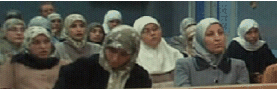 Bakaa
Teachers College, in the north, is in the only Islamic Institute in
Israel. We presented for approximately 60 teachers and student teachers
from the surrounding areas. The audience consisted of mostly young women
in varied but traditional dress. The few men in the group sat in the front
row apart from the women.
Bakaa
Teachers College, in the north, is in the only Islamic Institute in
Israel. We presented for approximately 60 teachers and student teachers
from the surrounding areas. The audience consisted of mostly young women
in varied but traditional dress. The few men in the group sat in the front
row apart from the women.
The
students were articulate and raised
issues about the difficulties of learning to read Arabic. We heard that
Arabic kids are more interested in learning Hebrew than English. It seems
to be related to the ways in which English and Arabic are being taught.
It seems that English teaching has been artificially sequenced with past
tense not introduced until 6th
grade; English is introduced in 3rd or 4th
grade usually although there is experimentation in some schools to introduce
it earlier. Focus is on following text books, taking dictation and copying.
Arabic parents are more interested in their kids knowing English, however
the kids seem to be aware of the economic and social importance of Hebrew.
The
college is proud of its library with over 30000 books in Arabic but they
have virtually no contact with libraries in other Middle Eastern countries.
The
English department at Bar
Ilan University sponsored us. There is obviously a big difference between
students and faculty at colleges and universities. Some faculty teach at
both. It seems that many Israelis have two or three jobs and some have
several part time jobs. This makes writing and researching problematic
although this is part of their responsibilities. Many of the professors
from universities are from countries outside of Israel while the faculty
at the colleges represent more native Israelis both Jewish and Arabic.
Israel is a wonderful laboratory for studying language and literacy. Professor
Bernard Spolsky and his students are doing important socio-linguistic research.
He was also part of the group involved in the development of the new English
curriculum.
We
spoke one evening for the English
Teachers Association of Israel (ETAI) at
Levinsky Teachers Training College in Tel Aviv.
The audience seemed to be interested and to know about our work. We thought
they would be mostly secondary teachers but it turned out that they were
teacher educators and advisors, inspectors and counselors
as well. The Association appears to be very active holding two national
conferences a year.The participants were knowledgable about EFL/ESL issues
and raised questions about the imposition of mandated curriculum in the
U.S.
The Arab
Teacher's College in Haifa is the only academic institution in Israel
that teaches in Arabic. We could not recognize Muslim and Christian students
only from their dress because many non religious Muslims dress as Israeli
Jews and Christians do. This
students in Haifa were sophisticated and articulate.. A problem, which
was raised with us, is that even when children in Arab villages are taught
by Arab teachers they are often urban and modern and come from backgrounds
different than their pupils.
In
Jerusalem we spoke at the American
Cultural Centerto
approximately sixty intermediate and high school teachers, teacher educators,
advisors and inspectors. This was also sponsored by the English
Teachers Association of Israel (ETAI). The audience was similar to
the Tel Aviv audience.
There was an inspector of English education there who said our talk was
very important at this time because of the new curriculum and the work
she is trying to do with the English teachers.
A
marker in the front of the college says that David
Yellin College served as the headquarters of the Haganah during the
war of independence.
Like most of the colleges we visited, we were impressed that the teacher's
colleges are very Spartan in design, not very well maintained in terms
of looks and equipment and there is little or no space for faculty to interact.
Perhaps it is the Spartan nature of the founders of Israel to focus on
the functional. Or perhaps it shows that education like every other aspect
of Israeli life has had to be subordinated to survival.
Our audiences at David Yellin were quite varied and showed us something
of the range of educators we met throughout Israel.
Most
of the educators we met were aware of the attacks on whole language in
the states though they were. very surprised at the severity of attacks.
We put them in the context of American politics. Janet Miller, who is the
language officer for the state department in the Middle East and Ben Ziff
who directs the American Cultural Center say that one of the purposes of
promoting English in the schools is that it is one curriculum area where
teachers feel freer to use more democratic curriculum and methods. Ben
Ziff and Fay Lipshutz from the American Cultural Center. debriefed us regarding
our trip. They wanted to know our impression of teacher education in English
in Israel, what we thought their role might be to promote English teaching
and how they could do better in relation to visitors like us and whether
we thought that they should work more closely with the public schools in
Israel. We told them that we thought that there were gaps of communication
between related groups such as universities and teacher education programs
and between teacher colleges, school administration and curriculum development.
Although a number of individuals have jobs in the schools, teach in the
university and have jobs in the teacher's colleges there don't seem to
be opportunities for interaction. We were impressed with the thoughtful
concerns and responses of the ministry personnel. They were not only interested
in our comments but seemed knowledgeable themselves about the issues we
were raising.
We
visited the Arab
Experimental School in Jaffa, and Magen, another experimental school
in the Telaviv area. Schools that are designated as experimental seem to
have more local control and are free to innovate in planned ways. Each
is expected to mentor another school in the same innovative approach. The
Jaffa school has
a focus on local culture. The principal is passionate about the history
of the Arabs in the Jaffa area and this is the content focus in the school.
The school includes Arab and Jewish cultures as well as English, Hebrew
and Arabic languages. Kids are cross aged in combined kindergarten and
first grade. There are 21 kids in these two grades with three teachers.
Kids were writing in all three languages and the teachers were organizing
their play to focus on literacy. There were environmental signs in all
languages. Symbols of all three cultures including Santa Claus, dreydles
and Ramadan figures and lanterns were visible.
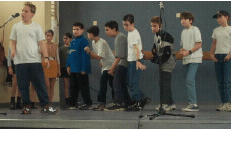 The
second experimental school we visited is Magen,
a
Jewish School, in an upscale neighborhood in the Telaviv area. This experimental
school focuses on multilingual and multicultural education, focussing on
Hebrew, Arabic, English and Japanese culltures. We saw English lessons
in third and fifth grades. There is a great deal of focus on music, art
and drama in this school. The 6th
grade put on an English production of segments of West Side Story, Romeo
and Juliet and Fiddler on the Roof for us. They were attempting to produce
the different dialects
The
second experimental school we visited is Magen,
a
Jewish School, in an upscale neighborhood in the Telaviv area. This experimental
school focuses on multilingual and multicultural education, focussing on
Hebrew, Arabic, English and Japanese culltures. We saw English lessons
in third and fifth grades. There is a great deal of focus on music, art
and drama in this school. The 6th
grade put on an English production of segments of West Side Story, Romeo
and Juliet and Fiddler on the Roof for us. They were attempting to produce
the different dialects
From
January 6 until the 13th
we worked with the Ministry of Education in Israel. We spoke at conferences
in Kiryat Shimona in the far North and in Jerusalem. Our audiences were
teachers, teacher educators and school administrators. We also consulted
with the staff of Elana Zeiler who is the head of elementary education
in Israel.
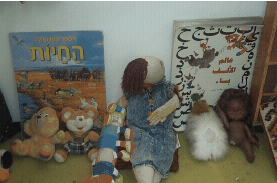 Misgav
is
in its second year as an experimental school,
where Jewish and Arab children are lesrnng literacy in Hebrew and Arabic
together. This is a first and second grade on the site of a regular school
within a Jewish village. There were teachers, inspectors and the principal.
Everyone was very enthusiastic. We met Ora, a consultant from the ministry
who is dedicated to Peace Now and integration of Arabs and Jews in the
society for coffee just before the school visit. Ora worked with David
Schwarzer and Bilha Artzi to develop this school. It was hard going the
first year. This year the first graders are doing even more with writing
and reading in Arabic and Hebrew than their counterparts in second grade.
The children are enthusiastic and involved in their work. The Arab inspector
was surprised at the writing the children were doing especially that children
could be writing at this young age in both Hebrew and Arabic and that they
were writing Arabic in the vernacular. Two children were sitting side by
side one Arab and one Jewish writing on computers in Arabic and Hebrew..
We met with the group of educators after our visit to the classrooms to
discuss what we saw and to respond to questions regarding multiliteracy
and other issues of the curriculum they are putting into place.
Misgav
is
in its second year as an experimental school,
where Jewish and Arab children are lesrnng literacy in Hebrew and Arabic
together. This is a first and second grade on the site of a regular school
within a Jewish village. There were teachers, inspectors and the principal.
Everyone was very enthusiastic. We met Ora, a consultant from the ministry
who is dedicated to Peace Now and integration of Arabs and Jews in the
society for coffee just before the school visit. Ora worked with David
Schwarzer and Bilha Artzi to develop this school. It was hard going the
first year. This year the first graders are doing even more with writing
and reading in Arabic and Hebrew than their counterparts in second grade.
The children are enthusiastic and involved in their work. The Arab inspector
was surprised at the writing the children were doing especially that children
could be writing at this young age in both Hebrew and Arabic and that they
were writing Arabic in the vernacular. Two children were sitting side by
side one Arab and one Jewish writing on computers in Arabic and Hebrew..
We met with the group of educators after our visit to the classrooms to
discuss what we saw and to respond to questions regarding multiliteracy
and other issues of the curriculum they are putting into place.
We
stayed in the Galillee at Kibbutz Kfar-Guiladi Hotel. This kibbutz is in
the far north beyond Kiryat Shimona in an area adjacent to the Golan Heights
and the buffer area of Lebanon. One major aspect of its work is the hotel.
It was shelled during the 1973 war with Syria. There are trenches around
the kibbutz as a reminder of the war and bunkers which were used since
we left during a flareup of hostilities with the Herzbalah in Lebanon.
The kibbutz was our base to visit other schoosl in the area.
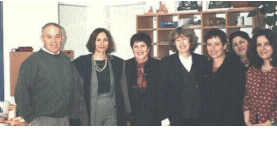
Omarim
is
a school North of Haifa, about six years old, which was formed by bringing
together separate schools at several surrounding kibutzim. It is committed
to carrying out the humanistic principles of the kibbutz philosophy. The
students study biblical issues as local history. This role in Israeli education
is an interesting one. One focus is teaching the bible as literature or
secular history. This school is involved in doing thematic projects with
their students. We were there on a math day. We visited a number of classes
and the library. We saw a computer presentation of the school and its philosophy
which was presented by the school principal, Ester Toren. After our tour
of the school we met with teachers, administrators and inspectors. Like
the Misgav school, the teachers here were articulate. They knew what they
were doing and why. They asked for our views and asked questions about
curricular issues. The inspector, educated in England, was very enthusiastic
about the school and a good spokesperson for its direction. We saw upper
grades in this school.
We
met at the kibutz with Ilana Zeiler director of elementary Education in
Israel and Belha Artzi on her staff in the ministry to discuss issues of
standards, testing, and literacy for elementary schools in Israel. This
group must respond to the Education Minister,s concerns for accountability
and at the same time try to sustain a focus on holistic practices in the
schools. Barak, Israeli prime minister, is anxious to solve all the education
problems by the end of his term. This means pressure for standards and
tests. The government want educational equality which means everyone being
able to reach the same goals in the same ways with the same materials and
tests.
The
Seminar theme at the Kfar Guiladi conference was "Promoting literacy in
the Information era". Ken discussed The Copernican revolution in reading
and aspects of his reading model.
Yetta
discussed early literacy development. Margaret Spencer, who toured for
the Ministry with us, discussed concepts of literacy, literature and the
role of schools. There were about 200 participants. There was a panel at
the end of the presentations. Questions were concerned with research to
support holistic teaching/learning, and the role of writing Arabic in the
vernacular. We got more questions about what is happening in Calfornia,
in England and why whole language is being attacked.
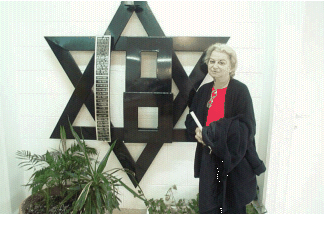
We
visited two schools in Kiriat Shimona. Both schools were subject to bombing
from Lebanon and terrorist attacks on children, teachers and their family
members. In one school, 27 children were killed a number of years ago.
One teacher's husband had been killed six month ago from a rocket attack.
We were told that this area has high unemployment and there are low achieving
children in the schools. The socio economic level of the students was not
obvious to us in the school setting. The schools are somewhat stark and
cold but well maintained.
The
first school included active and happy children involved in a range of
interesting reading and writing experiences. There was one composition
of a dialogue between Cain and God about killing Abel which showed good
insight into the biblical references but at the same time was updated and
humorous. We spent most of the time in primary classrooms. The classes
use the same trade book for everyone in the class. Not too many books were
in sight in this school. We visited with the teachers to give them our
reactions and to answer questions.
The
second school in Kiryat Shimona turned out to be the most controversial
situation during our time in Israel. The people at the teaching center
are using the genre theory to involve teachers in having students carefully
explicate the text. Their understanding of this was in evidence in the
classrooms where the students 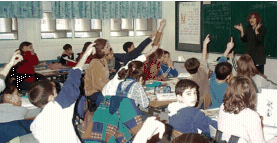 first
hear the teacher read a trade book (the same for all the kids in the classroom);
then they do an explicit exercise related to the text that involves them
in looking closely and recording specifically what is in the text, then
they paraphrase what they have learned and finally they can respond to
illustrations. We saw this in a number of primary and middle grade classes.
In the sixth grade we were able to converse with a few of the students
in English: a Russian boy and a boy who had lived in L. A. who were very
articulate. This school had the least amount of children's work on the
board and the most commercial materials in sight. We saw teacher's erasing
children's answers and children doing a lot of erasing of their own writing
on small charts they were filling in. The library was fairly well stocked
there were no children in sight.
first
hear the teacher read a trade book (the same for all the kids in the classroom);
then they do an explicit exercise related to the text that involves them
in looking closely and recording specifically what is in the text, then
they paraphrase what they have learned and finally they can respond to
illustrations. We saw this in a number of primary and middle grade classes.
In the sixth grade we were able to converse with a few of the students
in English: a Russian boy and a boy who had lived in L. A. who were very
articulate. This school had the least amount of children's work on the
board and the most commercial materials in sight. We saw teacher's erasing
children's answers and children doing a lot of erasing of their own writing
on small charts they were filling in. The library was fairly well stocked
there were no children in sight.
After
the classroom visits, we had a discussion with the teachers, inspectors,
administrators, advisors who seemed to be supporting using these ideas.
They presented their own ideas. Then Margaret Spencer, Ken and Yetta responded..
There was a great deal of discussion and argumentation. We spent a good
deal of time during the rest of the day and the next two days exploring
the issues presented in this school, the things the students were doing
and how the ministry group might respond. The consultants seemed genuinely
surprised that we didn't see their genre approach as compatible with whole
language. They thought that since they were promoting community and reading
of authentic texts they were doing whole language. To us it seemed that
the real issue is their lack of faith in teachers and in learners. They
said that these children needed more structure and the teachers needed
specific help because they couldn't do whole language. They see the genre
approach as controlling both and believe they have evidence that the children
are reading and writing better and more with this approach.
Back
in Jerusalem we stayed at Kibutz Ramat-Rachel. Their hotel was more luxurious
than the one at Kefar Guiladi but very similar in operation. The Ministry
sponsored another conference there, with about 150 people. The audience
included invited leading scholars in literacy and language studies, school
inspectors in the Israeli education system, people from teacher training
institutions and English teachers. The conference theme was: Literacy promotion
and official policy.
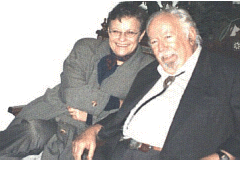
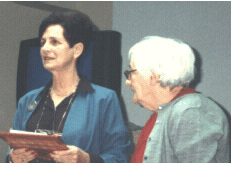 Margaret
Spencer presented about the issues in England, the pitfalls and what to
avoid and consider in Israel. Ken and Yetta worked together discussing
issues that affected U.S. policy selecting issues that were most important
in the Israeli scene. Our point was that these are issues that should be
argued professionally and not decided politically. The audience was sophisticated
and the questions involved standards, testing, dyglossia, technology, kidwatching
and the politics of education in the world.
Margaret
Spencer presented about the issues in England, the pitfalls and what to
avoid and consider in Israel. Ken and Yetta worked together discussing
issues that affected U.S. policy selecting issues that were most important
in the Israeli scene. Our point was that these are issues that should be
argued professionally and not decided politically. The audience was sophisticated
and the questions involved standards, testing, dyglossia, technology, kidwatching
and the politics of education in the world.
At
the kibbutz we met with the leading policy implementers in the elementary
education system of the ministry. This group seems to be the core group
in implementing holistic change in the ministry. Margaret Spencer showed
videos from the London Centre where she is working with Myra Barrs and
we critiqued the videos. It was obvious that there are attempts to do  holistic
practices within the literacy hour debacle that is required in British
public education. There were discussion, questions and responses throughout
the morning with the group assembled. The concerns were how to maintain
progressive, democratic and holistic education within the structure of
standards and testing.
holistic
practices within the literacy hour debacle that is required in British
public education. There were discussion, questions and responses throughout
the morning with the group assembled. The concerns were how to maintain
progressive, democratic and holistic education within the structure of
standards and testing.
We
saw videos by Bilha Artzi about how technology is being used in schools.
Mostly we viewed kids writing on computers and the way in which word processing
frees kids to write. They are integrating computers as early as first grade
and are documenting the results. Another group that presented was the Tsafta
group (togetherness in Hebrew). This group is supporting kids who might
otherwise be identified as special education. They have consultants to
help classroom teachers. Usually the consultant works with the rest of
the class while the classroom teacher is helped to work one-on-one directly
with a child. They use videos to demonstrate for teachers all over the
country. We saw a video where an outstanding consultant was working with
a child struggling with reading. There was an interview with the father,
who is an educator, about the problems his son was having in reading. The
child read a number of selections. The teacher selected material for the
students that was somewhat easier than the one the student chose for himself
and demonstrated the role of the teacher and material selection which revealed
the student's reading strategies. The interactions between the student
and the teacher was sophisticated and serious. It was similar to RMA in
some respects.
This
was a highly professional group with insightful questions all morning.
There was an Arab inspector whose child goes to the Misgav school and we
discussed the progress of Misgav. It is obvious that there are problems
about the use of vernacular in the writing of Arabic by young children.
They are also concerned with the ways in which English is taught and when
instruction should begin. Both of these areas are within Ilana's jurisdiction
but strongly influenced by traditions and the beliefs and approaches of
others.
Some impressions
The state of education in Israel
Though the schools of Israel are quite variable, it is clear that there
is considerable effort being put into making high quality education available
to all of Israel's students and to increasing professionalization of Israel's
teachers and administrators. Israel is moving toward requiring a full four
year college degree for teachers. It puts a lot of resources into staff
development and consultants for schools. We met many dedicated informed
professional teachers, teacher educators and administrators.
It is hard to make a living as a teacher or teacher educator in Israel.
Many work several jobs and do private tutoring on top of that. Even families
of modest means will hire tutors to help their students in school subjects
so that they will graduate and be able to pass the tough matriculation
exams at the end of high school. Yet we had relatively large audiences
wherever we spoke and found teachers familiar with our work, eager to learnand
able to articulate their beliefs. We met a number of professional educators
who would like to work on advance degrees or do post doctoral work in the
States. In our view this would be an important contribution to the future
of education in Israel.
Educators and some politicians in Israel recognize the need for change.
They have a system inherited two generations ago from the colonial British
with strong overlays from Jewish and Muslim educational traditions. Many
of their citizens were educated in non-democratic schools with rigid curricula.
They need schools that can be integrative of all, successful with all,
and productive of graduates able to participate in a democratic Israel.
From the perspective of our Israeli hosts, we came at an opportune time
because changes in the English language curriculum and in the general elementary
curriculum are occuring which it was felt our input could support. Throughout
our trip their were numerous informal opportunities to interact with educators
and with other Israelis.
We promised we wouldn't write a book about education in Israel as soon
as got home, but we feel we came back with a pretty good overview of the
situation. We made important contacts with researchers, teacher educators,
administrators, teachers, and Ministry officials. We're already in touch
with many by email. We've been able to put some in touch with professional
colleagues from the United States. There is interest in joint research.
We expect to stay involved in Israeli education at a number of levels for
the foreseeable future. There is some discussion of translating several
of our works into Hebrew.
What we learned.
All aspects and all issues of education, and particularly language education,
are visible in Israel. But the particular circumstances of Israel at the
turn of the third millenium have caused us to do some rethinking.
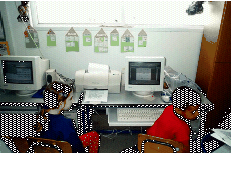 Consider
bi-lingual education. The founders of Israel were determined to establish
Hebrew as the living national language of Israel. They succeeded so well
that Arab educators told us Arab students are highly motivated to learn
Hebrew- even more than they are to learn English. Arabic is also an official
language of Israel and there is no chance of losing it- but it is mostly
the Israeli Arabs who know the two languages. Arabic is taught but not
learned in Jewish schools. English is taught as a foreign language in all
schools starting in fourth grade and there is strong parental pressure
to move it down to earlier grades. Jews poured into Israel from many nations
and brought many languages but there has been no policy of bilingual education
for these language speakers. The latest group of newcomers, the Russians,
have begun their own schools, after regular school, to teach the Russian
language and cullture. Now there are a few efforts to develop co-ordinate
bilingual Arabic- Hebrew programs. Bilingual education must be different
in its application in so complex a political, linguistic, cultural and
pedagogical situation.
Consider
bi-lingual education. The founders of Israel were determined to establish
Hebrew as the living national language of Israel. They succeeded so well
that Arab educators told us Arab students are highly motivated to learn
Hebrew- even more than they are to learn English. Arabic is also an official
language of Israel and there is no chance of losing it- but it is mostly
the Israeli Arabs who know the two languages. Arabic is taught but not
learned in Jewish schools. English is taught as a foreign language in all
schools starting in fourth grade and there is strong parental pressure
to move it down to earlier grades. Jews poured into Israel from many nations
and brought many languages but there has been no policy of bilingual education
for these language speakers. The latest group of newcomers, the Russians,
have begun their own schools, after regular school, to teach the Russian
language and cullture. Now there are a few efforts to develop co-ordinate
bilingual Arabic- Hebrew programs. Bilingual education must be different
in its application in so complex a political, linguistic, cultural and
pedagogical situation.
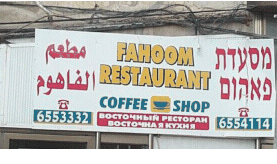 Similarly
we increased our understanding of the Hebrew and Arabic writing systems,
of the traditions of teaching them, and of the problems of bringing about
change in how they are taught. For example, both Hebrew and Arabic orthographies,
do not usually represent vowels in the written text. In both cases there
are sets of diacritical marks which can overlay the text to more fully
represent the phonology and morphology. But those are rarely seen except
in beginnng instructional materials and in sacred literature. For Arabic
the problem is more complex because Standard Modern Arabic derives from
Classic Arabic (the marked form) and is a foreign language for students
who speak one of the many contemporary dialects of Arabic. Furthermore
there are long religious traditions that place an importance on learning
to read Torah and the Koran even for young school beginners. For Arab students,
English is most likely to be the third foreign language they will learn
after Classic Arabic and Hebrew.
Similarly
we increased our understanding of the Hebrew and Arabic writing systems,
of the traditions of teaching them, and of the problems of bringing about
change in how they are taught. For example, both Hebrew and Arabic orthographies,
do not usually represent vowels in the written text. In both cases there
are sets of diacritical marks which can overlay the text to more fully
represent the phonology and morphology. But those are rarely seen except
in beginnng instructional materials and in sacred literature. For Arabic
the problem is more complex because Standard Modern Arabic derives from
Classic Arabic (the marked form) and is a foreign language for students
who speak one of the many contemporary dialects of Arabic. Furthermore
there are long religious traditions that place an importance on learning
to read Torah and the Koran even for young school beginners. For Arab students,
English is most likely to be the third foreign language they will learn
after Classic Arabic and Hebrew.
Teaching and learning English
English education in Israel has to be seen in the context of the linguistic
complexity of the country. Judging by the people we met, our impression
is that the majority of Israelis control oral and written English.And many
are literate in English even though they are reticent to speak it. It is,
in fact, the second language of the country, though it is the first language
for only a few. English has been taught, primarily, as a foreign language
with emphasis on grammar and vocabulary. But with so much access to English
in Israel its hard to attribute the high percent of Israelis competent
in English just to formal classes in schools. Unlike countries where English
is limited to a few academic and commerical functions, it is used much
more broadly in Israel. Israeli educational authorities are exploring more
holistic and democratic methodologies for English education that will put
development of English in its social context.
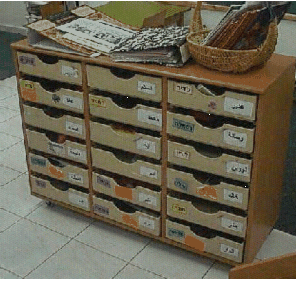 Innovation
Innovation
Change in curriculum and methodology is difficult to achieve in Israel;
still we found a wide range of innovative initiatives in both the Jewish
and Arabic sectors. Illustrative of these initiatives is the interest of
educators in Israel in whole language, a major factor in our being invited
to Israel.
Israeli educators see in whole language a broad pedagogy that integrates
the language processes with their use in learning across the curriculum.
As they struggle to create classrooms that can effectively teach all of
their diverse peoples they find this holistic, democratic pedagogy attractive
and useful. Both the new English curriculum and the national elementary
school curriculum draw on whole language principles. And there are a number
of experimental schools developing their own versions of whole language.
Here are some key whole language principles we found our audiences responding
to and which we found in use in schools we visited:
1. Building on the language and experience of the learners. Whole
language classrooms start where each learner is. Linguistic and cultural
diversity is accepted. Bilingualism and biliteracy are promoted. We saw
classrooms in which primary pupils were reading and writing in Hebrew,
Arabic, and English. There is a beginning of multilingual, multicultural
education in some schools and some classrooms. We were told that English
classrooms are somewhat freer to innovate than general classrooms.
2. Developing language and literacy through their use. We learn
language while we learn through language. Literacy develops early in whole
language classrooms. We saw classrooms in which first graders were reading
real books, keeping journals, and writing stories. In our discussions with
Israeli educators and in the new curricula we see attempts to develop language
and literacy through their use. That means moving away from language curricula
based on learning language as a prerequisite to its use. In the former
English curriculum, for example, past tense was not introduced until the
3rd year of instruction. The new curricullum moves away from
focus on sequential teaching of grammar and skills and is organized around
themes. Content and literacy development are both goals. Fortunately Israeli
pupils live in a culture in which it is easy to use their developing competence
in Hebrew, Arabic and English. That gives the school many authentic possible
experiences to build on. Junior High students throughout Israel do family
trees as they explore their roots. Schools also focus on exploring their
communities.
3. Building a community of learners. Whole language classrooms
are communities of learners in which there is respect for teachers and
learners and both the pupils and the teachers are empowered. They are democratic
societies in themselves. There is focus on collaborative and individual
problem solving. This was particularly evident in the consolidated kibbutz
school we visited and is in keeping with the philophies on which the kibbutzim
were founded Students have choice in what they read and what they write
about. We saw schools with a rich array of books and other materials in
the classrooms for young readers to choose from in each language. We observed
children comfortably discussing their work with classmates and their teachers.
4. Whole language depends on informed, committed , professional teachers.
Whole language can not be mandated, nor should it be. Teachers must build
a knowledge base about learning, about language, about child development,
about teaching, about culture and community. Each must build their own
applications of this knowledge base. In the several teacher education programs
we visited we saw much difference, but we saw professionals dedicated to
developing professional teachers. Teachers we met could express their educational
beliefs and relate these to their practices. Administrators, leaders in
the education ministry, and teacher educators recognize the importance
of staff development. We are proud to have been asked to support their
work. There seems to be a shortage of spaces in the teacher education colleges,
particularly for Arab students. The Arab Institute at Beit Berl told us
they have to turn away many qualified applicants.
Equity in Education
Israeli educators are concerned that educational opportunity is not
uniform for all children growing up in Israel. This is an embarrassment
to a culture whose heritage includes a fight for access to education. All
the schools we visited had adequate facilities and materials and dedicated
teachers. Still, quality of education in Israel depends on where pupils
live, their family income, whether Jew or Arab, heritage, parental choice,
and whether parents can afford tutors. We saw laudable attempts to change
this pattern by the professional educators but such efforts continued to
be overshadowed by the universal concern for survival of the State of Israel.
Education will certainly be a top priority when Israel achieves a lasting
peace with its neighbors.
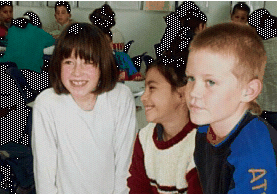
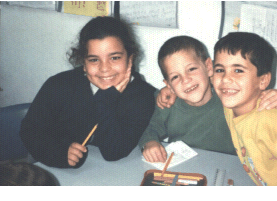
 For
about two years we have had interest in our making a professional visit
to Israel. We had invitations from Elana Zeiler, Director of Elementary
Eduation and Bilha Artzi of the Israel Ministry of Education, and from
Dr. Ruwaida Abu-Rass faculty member of Beit Berl college in Kfar Saba.
Dr. Abu Rass did her doctorate at the University of Arizona. She proposed
to the United States Information Service and the Cultural Attache that
they fund our trip. They agreed and we were funded under a section of the
Fulbright Program that provides support for English Teaching. Their policy
is to support scholars for a minimum of two weeks, They made known to other
educational groups and colleges that we would be available and put together
our program from December 19 to January 5. Our work for the Ministry was
from January 6 to January 13. We made about 27 presentations over the full
period of our visit, individually or together.
For
about two years we have had interest in our making a professional visit
to Israel. We had invitations from Elana Zeiler, Director of Elementary
Eduation and Bilha Artzi of the Israel Ministry of Education, and from
Dr. Ruwaida Abu-Rass faculty member of Beit Berl college in Kfar Saba.
Dr. Abu Rass did her doctorate at the University of Arizona. She proposed
to the United States Information Service and the Cultural Attache that
they fund our trip. They agreed and we were funded under a section of the
Fulbright Program that provides support for English Teaching. Their policy
is to support scholars for a minimum of two weeks, They made known to other
educational groups and colleges that we would be available and put together
our program from December 19 to January 5. Our work for the Ministry was
from January 6 to January 13. We made about 27 presentations over the full
period of our visit, individually or together.
 Our
schedule was arranged by
Our
schedule was arranged by  Our
only other trip to Israel was a three month visit in 1973. Change of all
kinds was obvious to us. The population has almost doubled to 6 million
including a million relatively recent arrivals from Russia and the other
former Soviet Republics. A million Arabs are citizens of Israel. And the
Jews of Israel are incredibly diverse including Falashas from Ethiopia,
North Africans, and Middle Easterners, and the Europeans including those
who came from North and South America, South Africa and Australia. Roads
are better, buildings higher, housing developments everywhere.
Our
only other trip to Israel was a three month visit in 1973. Change of all
kinds was obvious to us. The population has almost doubled to 6 million
including a million relatively recent arrivals from Russia and the other
former Soviet Republics. A million Arabs are citizens of Israel. And the
Jews of Israel are incredibly diverse including Falashas from Ethiopia,
North Africans, and Middle Easterners, and the Europeans including those
who came from North and South America, South Africa and Australia. Roads
are better, buildings higher, housing developments everywhere. 
 Like
many Israeli institutions,
Like
many Israeli institutions,  Bakaa
Teachers College, in the north, is in the only Islamic Institute in
Israel. We presented for approximately 60 teachers and student teachers
from the surrounding areas. The audience consisted of mostly young women
in varied but traditional dress. The few men in the group sat in the front
row apart from the women.
Bakaa
Teachers College, in the north, is in the only Islamic Institute in
Israel. We presented for approximately 60 teachers and student teachers
from the surrounding areas. The audience consisted of mostly young women
in varied but traditional dress. The few men in the group sat in the front
row apart from the women. The
second experimental school we visited is
The
second experimental school we visited is  Misgav
is
in its second year as an experimental school
Misgav
is
in its second year as an experimental school

 first
hear the teacher read a trade book (the same for all the kids in the classroom);
then they do an explicit exercise related to the text that involves them
in looking closely and recording specifically what is in the text, then
they paraphrase what they have learned and finally they can respond to
illustrations. We saw this in a number of primary and middle grade classes.
In the sixth grade we were able to converse with a few of the students
in English: a Russian boy and a boy who had lived in L. A. who were very
articulate. This school had the least amount of children's work on the
board and the most commercial materials in sight. We saw teacher's erasing
children's answers and children doing a lot of erasing of their own writing
on small charts they were filling in. The library was fairly well stocked
there were no children in sight.
first
hear the teacher read a trade book (the same for all the kids in the classroom);
then they do an explicit exercise related to the text that involves them
in looking closely and recording specifically what is in the text, then
they paraphrase what they have learned and finally they can respond to
illustrations. We saw this in a number of primary and middle grade classes.
In the sixth grade we were able to converse with a few of the students
in English: a Russian boy and a boy who had lived in L. A. who were very
articulate. This school had the least amount of children's work on the
board and the most commercial materials in sight. We saw teacher's erasing
children's answers and children doing a lot of erasing of their own writing
on small charts they were filling in. The library was fairly well stocked
there were no children in sight. 
 Margaret
Spencer presented about the issues in England, the pitfalls and what to
avoid and consider in Israel. Ken and Yetta worked together discussing
issues that affected U.S. policy selecting issues that were most important
in the Israeli scene. Our point was that these are issues that should be
argued professionally and not decided politically. The audience was sophisticated
and the questions involved standards, testing, dyglossia, technology, kidwatching
and the politics of education in the world.
Margaret
Spencer presented about the issues in England, the pitfalls and what to
avoid and consider in Israel. Ken and Yetta worked together discussing
issues that affected U.S. policy selecting issues that were most important
in the Israeli scene. Our point was that these are issues that should be
argued professionally and not decided politically. The audience was sophisticated
and the questions involved standards, testing, dyglossia, technology, kidwatching
and the politics of education in the world. holistic
practices within the literacy hour debacle that is required in British
public education. There were discussion, questions and responses throughout
the morning with the group assembled. The concerns were how to maintain
progressive, democratic and holistic education within the structure of
standards and testing.
holistic
practices within the literacy hour debacle that is required in British
public education. There were discussion, questions and responses throughout
the morning with the group assembled. The concerns were how to maintain
progressive, democratic and holistic education within the structure of
standards and testing.  Consider
bi-lingual education. The founders of Israel were determined to establish
Hebrew as the living national language of Israel. They succeeded so well
that Arab educators told us Arab students are highly motivated to learn
Hebrew- even more than they are to learn English. Arabic is also an official
language of Israel and there is no chance of losing it- but it is mostly
the Israeli Arabs who know the two languages. Arabic is taught but not
learned in Jewish schools. English is taught as a foreign language in all
schools starting in fourth grade and there is strong parental pressure
to move it down to earlier grades. Jews poured into Israel from many nations
and brought many languages but there has been no policy of bilingual education
for these language speakers. The latest group of newcomers, the Russians,
have begun their own schools, after regular school, to teach the Russian
language and cullture. Now there are a few efforts to develop co-ordinate
bilingual Arabic- Hebrew programs. Bilingual education must be different
in its application in so complex a political, linguistic, cultural and
pedagogical situation.
Consider
bi-lingual education. The founders of Israel were determined to establish
Hebrew as the living national language of Israel. They succeeded so well
that Arab educators told us Arab students are highly motivated to learn
Hebrew- even more than they are to learn English. Arabic is also an official
language of Israel and there is no chance of losing it- but it is mostly
the Israeli Arabs who know the two languages. Arabic is taught but not
learned in Jewish schools. English is taught as a foreign language in all
schools starting in fourth grade and there is strong parental pressure
to move it down to earlier grades. Jews poured into Israel from many nations
and brought many languages but there has been no policy of bilingual education
for these language speakers. The latest group of newcomers, the Russians,
have begun their own schools, after regular school, to teach the Russian
language and cullture. Now there are a few efforts to develop co-ordinate
bilingual Arabic- Hebrew programs. Bilingual education must be different
in its application in so complex a political, linguistic, cultural and
pedagogical situation.
 Similarly
we increased our understanding of the Hebrew and Arabic writing systems,
of the traditions of teaching them, and of the problems of bringing about
change in how they are taught. For example, both Hebrew and Arabic orthographies,
do not usually represent vowels in the written text. In both cases there
are sets of diacritical marks which can overlay the text to more fully
represent the phonology and morphology. But those are rarely seen except
in beginnng instructional materials and in sacred literature. For Arabic
the problem is more complex because Standard Modern Arabic derives from
Classic Arabic (the marked form) and is a foreign language for students
who speak one of the many contemporary dialects of Arabic. Furthermore
there are long religious traditions that place an importance on learning
to read Torah and the Koran even for young school beginners. For Arab students,
English is most likely to be the third foreign language they will learn
after Classic Arabic and Hebrew.
Similarly
we increased our understanding of the Hebrew and Arabic writing systems,
of the traditions of teaching them, and of the problems of bringing about
change in how they are taught. For example, both Hebrew and Arabic orthographies,
do not usually represent vowels in the written text. In both cases there
are sets of diacritical marks which can overlay the text to more fully
represent the phonology and morphology. But those are rarely seen except
in beginnng instructional materials and in sacred literature. For Arabic
the problem is more complex because Standard Modern Arabic derives from
Classic Arabic (the marked form) and is a foreign language for students
who speak one of the many contemporary dialects of Arabic. Furthermore
there are long religious traditions that place an importance on learning
to read Torah and the Koran even for young school beginners. For Arab students,
English is most likely to be the third foreign language they will learn
after Classic Arabic and Hebrew.
 Innovation
Innovation

